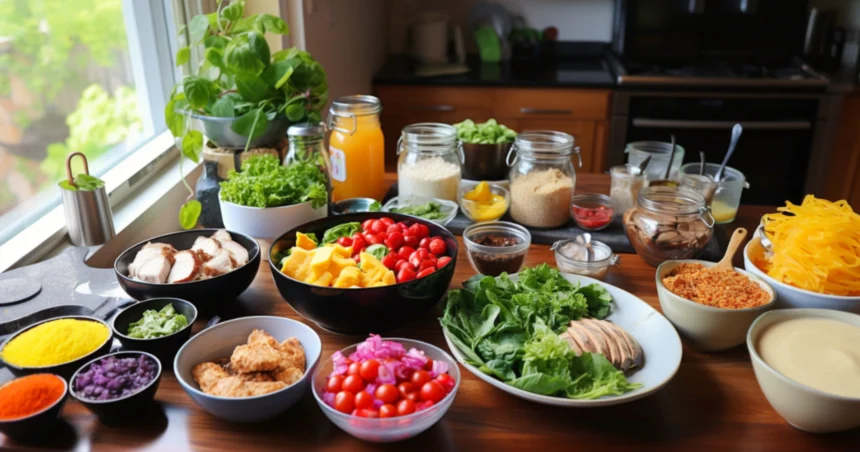In today’s fast-paced world, meal prepping has emerged as a game-changer. Imagine diving into a week, armed with a plan for every meal and a fridge stocked with nutritious delights. That’s the beauty of meal planning. It’s not just about saving time; it’s about ensuring you’re fueling your body right, even on the busiest days. With meal planning, you bid adieu to last-minute unhealthy takeouts and embrace a lifestyle that’s as organized as it is delicious. The benefits? Countless!
Quick Note on Meal Prepping
At its core, meal prepping is the art of preparing and organizing meals in advance. It’s like having a mealtime roadmap, guiding you through days, or even weeks, of dishes. No more scrambling through the fridge or settling for a bag of chips because you ran out of options. With meal prepping, you’re always a step ahead.
But here’s the thing – meal prepping isn’t one-size-fits-all. The beauty lies in its adaptability. Whether you’re a vegan, a meat-lover, a novice in the kitchen, or a seasoned chef, there’s a meal prep strategy for you. Some might choose to prep ingredients for a week’s worth of smoothie bowls due to a hectic morning schedule, while others might batch-cook stews for dinner because of evening commitments. Your personal goals play a role too. Training for a marathon? Your prep might lean towards protein-packed dishes. On a budget? There are cost-effective meal prep strategies to keep your wallet and plate full.
Here’s the golden nugget: amidst our jam-packed schedules, meal prepping is a lifeline. It’s not just about having food ready. It’s about ensuring that food is wholesome and aligns with our health goals. When life gets chaotic, our diet shouldn’t be the casualty. Meal prepping ensures it isn’t.
Steps to Effective Meal Planning
Planning Your Meals
The first step in successful meal planning is deciding what meals you’ll prepare. This involves selecting recipes that align with your dietary preferences and cooking abilities. The act of recipe planning is crucial as it helps streamline your shopping list, reduce food waste, and ensure variety in your diet. Start by identifying your preferred recipes, considering factors like nutritional value, preparation time, and ingredient availability. Once you’ve decided on the meals, list the recipes and the corresponding ingredients required. This proactive approach will not only save time but also minimize stress during the cooking process.
Choosing Your Mealtime
For beginners, the idea of prepping every meal might feel overwhelming. That’s why it’s wise to start small. Choose one mealtime to kick things off. Breakfasts are a great place to begin; think overnight oats or smoothie packs. Lunches, with salads or wraps, can also be a good starting point. The key is to pick a mealtime that typically feels rushed or unplanned, and let meal prepping swoop in to save the day.
Picking a Day for Meal Prepping
Pencil in a date with your kitchen. Yes, block out a day in your calendar dedicated to chopping, sautéing, and batch cooking. Sundays or Wednesdays are popular choices because they help split the week nicely. But hey, if you’re a “Thank God It’s Friday” type who loves to celebrate the end of the workweek with some culinary action, then go for it. The key is consistency, so pick a day that fits your rhythm and stick with it.
Preparing Your Ingredients
Alright, it’s time to roll up your sleeves and dive into the heart of meal prepping. You’ve got a few strategies to pick from here. ‘Make-ahead meals’ are like those TV dinners, only healthier and tastier because you’re in charge. ‘Ready-to-cook ingredients’ is the meal prep equivalent of a head start in a race — do the heavy lifting beforehand and cross the finish line with ease on the day. ‘Batch cooking’ is for those who find comfort in the familiar — cook once, eat thrice (or more). Choose your weapon based on your schedule, culinary preferences, and how much you enjoy (or don’t enjoy) cooking during the week.
Storing Your Meals
Last but definitely not least, let’s talk storage. Think of it as tucking your meals into bed — they need the right environment to stay fresh and tasty. Airtight containers are your best friends here. They keep the air out and the flavors in. If you’re going to eat the meal within a few days, the fridge is your go-to. For anything longer, the freezer is your culinary time capsule. And don’t forget to label your meals unless you enjoy surprise meals — that could be a fun twist to your meal prepping adventure. Good storage isn’t just about preserving your food; it’s about making your life easier when you’re dashing out the door and need to grab a meal.
Tips for Successful Meal Planning
Remember, Rome wasn’t built in a day, and neither is a perfect meal prep routine. Start small — maybe with prepping breakfasts or packing lunches for the workweek. As you get the hang of it, you can start to expand your meal prepping repertoire. Choose recipes that make your taste buds dance. After all, meal prepping is not just about convenience, it’s about enjoying your meals too. Plan your meals before your grocery trip to avoid impulse buys and stick to your budget.
Final Thoughts
Meal planning is more than just a kitchen strategy; it’s a lifestyle game-changer. By investing a bit of time upfront, you pave the way for stress-free days, delicious meals, and a health-focused approach to eating. The rewards? Reduced waste, more savings, and consistently nutritious choices, even on the most hectic days. Give meal planning a try – the results might surprise you!









